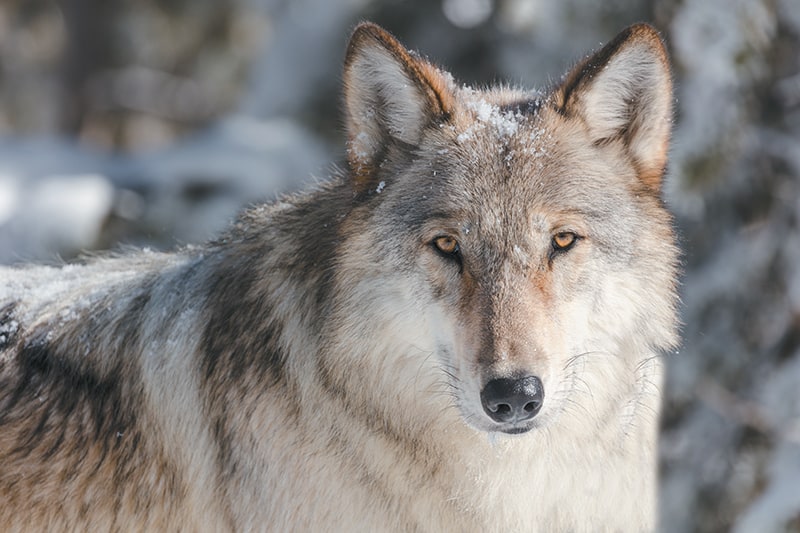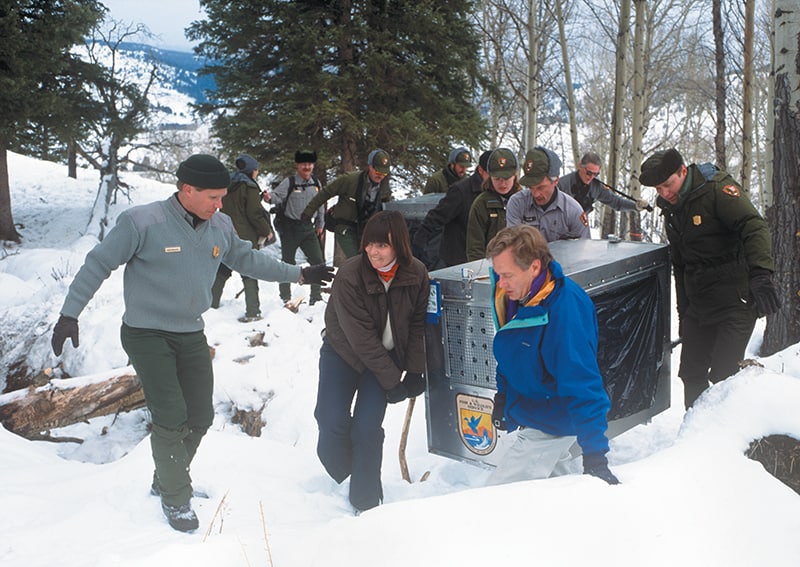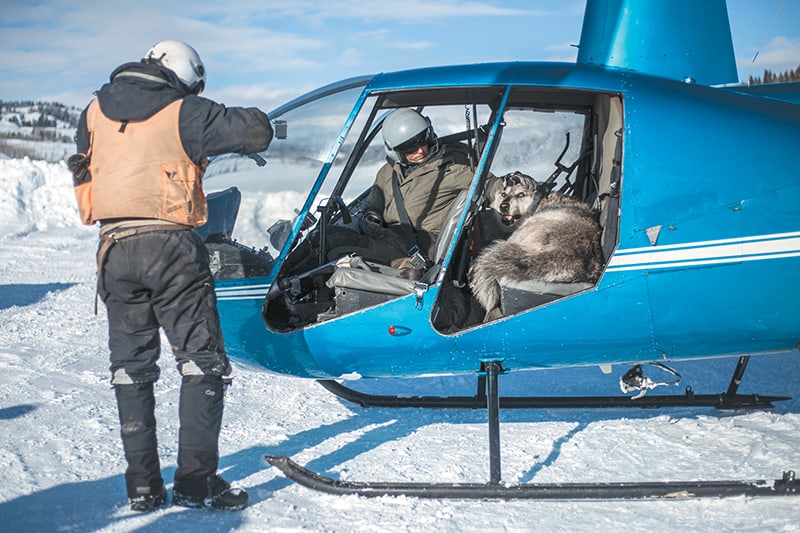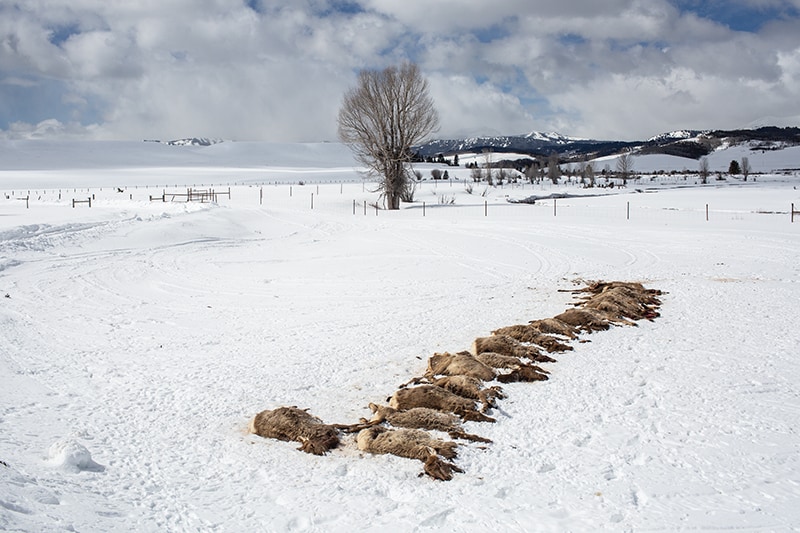Read The
Current Issue
Silver Anniversary
Twenty-five years ago, wolves were reintroduced to Yellowstone National Park. Today, gray wolves in the Greater Yellowstone Ecosystem are a wildlife success story, but no less of a lightning rod than they were in 1995.
By Mike Koshmrl

Photo by Jacob W. Frank / NPS
PEERING DOWN FROM a hill with a small group of reporters, Angus M. Thuermer Jr., then editor of the Jackson Hole News, caught his first glimpse of an extirpated native canine back on its home range in Yellowstone National Park.
It was the second week of January a quarter century ago, when a fleeting silhouette loping through the woods caught the then 40-something newsman’s eye. “Wolf,” Thuermer writes of his first glimpse of Canis lupus in a front-page News story. “It is the floating nature of the gait, the size of the head, the erect ears and thick fur that make this animal distinct. Purposeful and relentless in its stride, it glides in and out of the trees as it cruises the perimeter of its one-acre pen at Crystal Creek.”
The wolf he glimpsed was one of 14 that ran in three packs trapped in the Canadian wild outside of Hinton, Alberta, then tranquilized, collared, and transported south to Yellowstone. These 14 were the first wolves in the park in seven decades, except for a few itinerant animals that had sporadically passed through. In 1996 the U.S. Fish and Wildlife Service repeated its reintroduction efforts. To make sure there’d be a wide and healthy mix of genes in Yellowstone’s new wolf population, the second group of imported wolves came from packs that roamed the area around Dawson Creek, British Columbia. Both of these groups, 31 wolves in total, lived for their first several months in Yellowstone in open-air acclimation pens. They were fed road-killed elk and other animals until biologists believed they were ready for their new Wyoming lives in the wild.
With wolves back in the park for the first time since the 1920s, Yellowstone was home to all native megafauna that scientists believe resided in the region prior to European fur traders arriving in the West. This reunion of the carnivore and the world’s first national park solidified Yellowstone’s status as one of the largest and most intact temperate-zone ecosystems in the world. Biologists and activists who had been pushing and planning for wolf reintroduction for decades were elated to cross the finish line. Mollie Beattie, the U.S. Fish and Wildlife Service’s first-ever female director, was based in Washington, D.C., but traveled to Yellowstone to watch in person the historic operation she’d approved. According to Thuermer’s account, Beattie said, “This is sort of like running D-Day. When you think about catching wild wolves in Canada, transporting them, bringing them through customs, going through the legal process, sitting here watching them running around their pen is almost an indescribable sense of relief and happiness. They look great.” That day, almost every major newspaper and television news station in the country led with lobos loping in Yellowstone once again, albeit in one-acre pens.
Not everyone supported the reintroduction. The Wyoming Farm Bureau Federation (WFBF) viewed wolves as “livestock-killing oversized vermin.”
Not everyone supported the reintroduction. The Wyoming Farm Bureau Federation (WFBF), a member-financed grassroots organization that supports agriculture and private property rights in the state, viewed wolves as “livestock-killing oversized vermin.” The group persistently challenged the reintroduction of the species, including after the animals had been captured and sent to Yellowstone.
The State of Wyoming government was never on board, either. Representatives and senators who had family and constituent ties to the agricultural industry dominated Wyoming’s statehouse. The governor at the time, Jim Geringer, fought the reintroduction effort until the end. “Amidst the joy and bitterness, I remain seriously concerned with the uncertainty that continues to surround Yellowstone wolf reintroduction as it moves forward,” Geringer wrote to U.S. Secretary of the Interior Bruce Babbitt after wolves were on the ground in their pens.
ONE OF THE most widespread large carnivores on the planet, wolves had largely been exterminated by settlers and homesteaders south of Canada by the 1920s. A species that frequently preyed on livestock, wolves did not square with the Manifest Destiny and anti-predator mentality that ruled the settlement era. Poison, bounties, traps, and guns were employed until wolves were no more. (A small population of wolves did remain in northern Minnesota, in and around Voyageurs National Park.)
Discussion of reintroducing wolves to Yellowstone dated to the 1960s, when the National Park Service changed its wildlife management policy to allow populations to manage themselves. In 1973, the Endangered Species Act (ESA) was born, and the long process of coordinating a wolf restoration in Yellowstone began. It took another 16 years for Congress to appropriate money so that Yellowstone could actually study the operation with an environmental impact statement, and start planning in earnest for a reintroduction.
There’s no one person responsible for the reintroduction of wolves to Yellowstone, but Renee Askins was a crucial advocate. Outside magazine wrote that Askins was “to wolves what Jane Goodall was to chimpanzees.” Bruce Babbitt called her the “den mother” of wolf reintroduction. A native of Michigan with a master’s degree from Yale University’s School of Forestry and Environmental Studies, Askins began advocating for wolves to be reintroduced to Yellowstone in the late 1970s. She moved to Jackson Hole in 1981 to work closer with agencies and organizations supporting reintroduction. In 1988, after seeing how little progress had been made, Askins founded The Wolf Fund. The nonprofit group had one purpose: to make the reintroduction of wolves to Yellowstone a reality. (Askins promised to shutter it as soon as reintroduction happened.)
At The Wolf Fund, Askins worked to swing public opinion in Wyoming, Idaho, Montana, and beyond. “Our whole strategy was to try to understand what the specific concerns were and then to address them literally one by one,” Askins said in a 2014 interview with the Jackson Hole News&Guide. “My staff called it ‘behind enemy lines lecture tours.’ Western agriculture had been in control of the politics of the West for so long that no one thought there was a chance in hell it would ever fly.” Askins received numerous death threats. Profanity-rich messages were left daily on the fund’s answering machine. Still, on March 21, 1995, fund staff, as Askins had promised, hung a sign on the office door: “Shut down.” Earlier that day biologists had opened the first wolf pen, freeing wolves into the wide wilds of Yellowstone.
WHILE THERE HAS been no consensus reached legally or politically in the 25 years since wolf reintroduction, biologically it is an unmitigated success. After the species’ roughly 70-year absence from the ecosystem, they returned to intact habitat, abundant big game like elk and deer, and an initial prohibition against being hunted due to their protected, “threatened status” under the ESA. Within five years of their reintroduction, the number of wolves had grown to 177. They lived in 18 packs and had expanded their territory well beyond Yellowstone’s boundaries. Wolves reached Jackson Hole in 1999, according to the Jackson Hole News story titled “Wolves Reach Refuge Hills.” The Gros Ventre Pack became established that year, denning in its namesake area on the eastern side of the valley. Today, more than a dozen wolf packs roam the greater Jackson Hole area, including some that den as close to town as the National Elk Refuge north of Jackson and Horse Creek south of town.
The reintroduction of wolves has influenced the Greater Yellowstone Ecosystem (GYE) in ways ecologists are still trying to understand. Ungulate populations, in places, have declined. Some meso-carnivores, like coyotes, have similarly been reduced in number by the return of their larger canine competitors. On the other hand, there’s been a “trophic cascade”—essentially a trickle-down effect of impacts—that in some cases benefit other wildlife and plant species. Depending on the species and/or your point of view, the re-introduction of wolves has been positive or negative. As often happens, people on both sides have overblown the impacts of the wolf’s return to the GYE.
A case-in-point from wolf supporters is a 2014 viral video, “How wolves change rivers.” Made by the British writer and wildlife advocate George Monbiot, the four-minute film exaggerated and oversimplified the cascade resulting from wolves’ return to the GYE. According to Monbiot’s film, the reintroduction of wolves changed the behavior of elk and other ungulates that, in the absence of an alpha-predator, had been overgrazing willows and other lowland plants. The short clip stated that, with wolves in the park, river bottom plant communities bounced back and an array of wildlife returned, ultimately bringing the ecosystem into a harmonic balance.
This is a lovely narrative, but actual data about willow regrowth in wolf territory suggests it’s just not true, says Colorado State University ecology professor Tom Hobbs. “It is true that wolves eat coyotes, and just about every other statement in that video is false,” he said in an interview with the Jackson Hole News&Guide. “All of the claims about the explosion of the riparian communities … there’s not a shred of scientific evidence that supports them.”
Equally misleading are wolf opponents’ cries that the animals are an unrelenting carnivorous force on the landscape, causing the populations of big game herds to crash. Ecological systems are complex, and predator-prey relationships in wolf country are rarely straightforward. A recently completed 15-year study on elk mortality and wolves led by Idaho Department of Fish and Game wildlife biologist Jeff Horne found that winter severity and food availability—not wolves—were the factors most correlated to elk calf mortality. Among predators of elk calves, wolves weren’t even the number-one stressor—that honor went to mountain lions, according to an academic study Horne published in the Journal of Wildlife Management.
There’s also groundbreaking information coming from research out of northern Minnesota’s Voyageurs National Park, which has a wolf population of between 30 and 50 animals living in six to nine packs. (Northern Minnesota is the only place in the Lower 48 states where humans and human activities did not extirpate wolves; the animals have lived in the area for thousands of years.) A large team of University of Minnesota and National Park Service biologists studying the summer diets of area wolves found the animals eat a much more varied diet than previously thought. Their study, published in the journal Mammalian Biology, revealed that beavers, berries, and even fish are major sources of sustenance for one of the park’s packs they’ve been tracking since 2015. The same study showed that ungulates—deer and moose—do make up about 80 percent of the park wolves’s calories. But the fact the wolves were eating beavers and berries upended the presumption that Canis lupus almost exclusively gets by on big game.
Studies of ungulates and wolf packs in Wyoming’s Buffalo Valley and northern Grand Teton National Park show wolves have contributed to a decline in moose and mountain lion populations. National Park Service wolf predation research and Teton Cougar Project lion mortality data back these studies up. There’s also been much speculation that wolves have played a role in redistributing elk in parts of Jackson Hole, particularly moving wapiti out of the Gros Ventre River drainage in winter. University of California-Berkeley and Wyoming Game and Fish investigations are underway in an effort to better understand what’s happening. “If the wolves were going to kill all the elk,” says Ed Bangs, who coordinated the wolf reintroduction for U.S. Fish and Wildlife before retiring in 2011, “they probably would have done it thousands of years ago.”
Regardless of what science says, there’s no doubting how divisive wolves were, and still are.
JOHN LUND, WHO supervises the Wyoming Game & Fish Department’s Pinedale Region, vividly recalls the uproar created by the image of 19 elk killed by a wolf pack in a single night in 2016 at the McNeel feedground in the Upper Hoback River Basin. Lund says the media maelstrom and public outcry that followed was one of the most chaotic days of his career. Just one journalist caught wind of the incident the day it happened, but within 24 hours writers from around the world began to swarm, drawn in by an image of a line of dead elk, many of them calves and none of them eaten.
The massacre was a rare instance of a wolf pack “surplus killing” wild ungulates. “Of course, it went viral on Facebook almost instantly,” says Lund. “I started getting calls from the local news media people first. Then some of the statewide newspapers and TV stations. About midday, I started getting calls from CNN, Fox News, The New York Times. I talked to a reporter in France. That day I think I spent six or seven hours on the phone nonstop. It was incredible … I heard comments from both extremes. Very passionate, hateful comments. From both sides.”
Currently, Facebook pages like “Kill the wolves” and “Kill the wolves in Wyoming” have thousands of followers. Peruse these pages’ posts and you’ll see photos of hunters posing with wolves they’ve killed, and memes that play off killing wolves. If you’ve seen bumper stickers like “SSS: shoot, shovel, and shut up” or “Smoke a pack a day” and wondered what they meant, both show support for killing wolves.
These represent the most extreme anti-wolf factions, but an uneasiness and even disdain for the species still pervades old West culture and politics inside and outside of the GYE in Wyoming. One policy implication of this is Wyoming’s “predator zone:” In 85 percent of the state, wolves are classified as vermin that can be shot on sight any time of year.
Ken Mills, the state’s leading wolf biologist and an employee of the Wyoming Game and Fish Department, deals in science. But he also has to take into account the politics of and interest in balancing wolf populations with those of other wildlife species, like elk. When people spout anti-wolf rhetoric, he spends a lot of time pondering their motivations. “Why do I have this outfitter upset about a smaller wolf-hunting mortality limit?” Mills says. “Does he hate wolves? Maybe. But he really loves elk, and he thinks that the one threatens the other. The motivation isn’t necessarily about hating wolves, it’s about wanting something [else] more than wanting wolves.”
Wolves were removed for the third, and possibly final, time as a “threatened” species under the ESA in 2017.
ONLINE, AMONG THE memes and bloody hunters posing with wolves they’ve shot, you will also find accounts of real-life hardships that come with living in wolf country. Hunters targeting other game have had their dogs attacked and/or killed by wolves. Every year, ranchers lose livestock to wolves. (The confirmed wolf-killed toll in Wyoming in 2018, the last year data was available, was 70 head of livestock, but that total swings significantly year to year. Cattlemen and sheep growers are reimbursed with state funds for their losses, however, and in 2018 the payouts totaled $169,000.)
Chronic conflict along the leading edges of wolf range over the decades since reintroduction suggests that wolves have much more difficulty living amid development and near people than carnivores like coyotes, black bears, and even mountain lions. Still, “If wolves continue to increase, they could live almost anywhere,” world-renowned wolf biologist Dave Mech wrote in 2017. “The real question society must face is, Where will people tolerate them? Will many folks want to live out of fear, valid or not, while out for walks at night? How many will be willing to risk their dogs and cats being killed? Their livestock? Will many folks tolerate large numbers of wolves being killed legally and/or illegally around their suburbs and cities?” Mech, who at 82 continues to churn out research, wrote those words in Biological Conservation, a peer-reviewed journal. His article was titled, “Where are wolves and how can we live with them?”
The same types of disagreements and antagonism about wolves that exist in the West exist elsewhere, Mech says, including Minnesota and the Great Lakes states, where he calls home. There are even similar sentiments across the Atlantic Ocean, in European countries where wolves are naturally reclaiming old grounds where they were wiped out decades ago. Worldwide, there is a stark urban/rural divide in terms of how people view wolves: There is strong support for the species in metropolitan areas, but the enthusiasm wanes significantly as you move into the countryside where wolves actually live. “The animosity towards wolves, especially by rural folks who have to live with them, that originally caused the extirpation of the species has not abated,” Mech writes. “Even though positive attitudes towards wolves generally predominate, primarily by urbanites, the animosity is personal and strong enough that it can often prevail.”
Education, in Mech’s view, is one factor that could help turn the corner on both the vilification and glorification of wolves. “That certainly will help many people, but you’re always going to have people on both sides of the issue who don’t really care about what science says,” he says in an interview. Bangs, the former USFWS employee, likes to say that wolves are “just another animal.” It’s humans, he says, who are interesting, and are mired in a wolf debate that’s all about humans debating human values, but “using the symbol of an animal to do it.”
WOLVES ARE IN the Greater Yellowstone Ecosystem to stay, thanks to the ESA and the fact that in parts of the region, like Yellowstone National Park, individual states don’t have jurisdiction. Wolves were removed for the third, and possibly final, time as a “threatened” species under the ESA in 2017. This gave Wyoming control over the species’ population, and the state promptly instated a wolf hunt. (Montana and Idaho have had control over their wolf populations since 2011, when Senators Mike Simpson (R-ID) and Jon Tester (D-MT) included, on a budget bill, a rider that overrode the ESA in their states, and prohibited future legal challenges.) Wyoming wasn’t included in this deal, and the state has faced steady legal challenges to its wolf management plan partly due to its free-fire “predator zone,” which no other state with a wolf population has.
In northwest Wyoming, the core of the GYE, there are wolf population goals, hunting seasons, and limits on how many lobos can be killed in a season. But beyond this mountainous area—part of the year the southern boundary is Teton County’s Highway 22—is the 85 percent of the state in which wolves are deemed “predators” and “vermin.” Here they can be killed indiscriminately, without licenses, seasons, or limits. “The predator status was a big middle finger to the feds,” Bangs says. “It was all about the symbolism of it. It was just a political statement of, ‘We never wanted wolves, we don’t like wolves, and we still don’t like wolves.’ But in reality, I don’t think it makes much difference where [the boundaries are] drawn.” Wolves, he says, don’t survive long anywhere in agricultural or open high-desert environments, or even in wild mountain ranges that teem with grazing allotments—especially those occupied by sheep, like the Bighorn and Wyoming Ranges.
While the species struggles to persist in the free-fire zone making up the majority of the state, a somewhat stable population does exist in the core of Wyoming’s portion of the GYE, which is about 15 percent of the state. Today, around 300 wolves live in this area, including Yellowstone’s population. In the states of Montana, Wyoming, and Idaho collectively, there are about 1,500 wolves. The majority can be traced to the 1995 and ’96 reintroductions; others reintroduced themselves, leaking south across the Montana border from an expanding population that’s contiguous with Canada’s estimated 60,000 wolves.
Fifteen hundred vastly exceeds the delisting goals that were agreed to when wolves were reintroduced. The success of the reintroduction here was wholly expected, Bangs says. “Wolves are big, bold, adaptable, resilient large predators. Once you turned them loose in really good habitat, they did really, really well. It’s not like we were really smart. They are just really good animals.” JH
A timeline of wolves in the Greater Yellowstone Ecosystem
Dates provided by Earthjustice
1800s–1930s: Wolf population in Continental U.S. decimated.
1973: Endangered Species Act (ESA) becomes law.
1974: Wolves listed as “endangered” under the ESA.
1982: ESA modified to allow for “experimental, nonessential” populations, the tool that gave managers more flexibility in managing a reintroduced population
1995: Wolves reintroduced to Yellowstone National Park and central Idaho. Yellowstone National Park wolf population: 14
2003: Wolves reclassified under the ESA as “threatened” rather than “endangered”; work begins to delist Northern Rockies populations. Yellowstone National Park wolf population: 174
2007: Proposal made to take wolves in Montana and Idaho off the Endangered Species List. The proposal does not include Wyoming’s wolves because of the state’s management plan, which includes allowing the species to be shot on sight and without a license in a large portion of the state.
2008: Wolves delisted in the spring, but environmental groups sue and federal protections are reinstated the same summer. The legal back-and-forth continues for years. Yellowstone National Park wolf population: 124
2011:Legislation delists wolves in the Northern Rockies, except for Wyoming’s population (again, because of Wyoming’s proposed management plan for the species).
2012: Wyoming’s wolves delisted and first modern-day, legal wolf hunt is held.
2014:Federal judge reverses status of Wyoming’s wolf population back to “threatened.”
2017:Appeals court reverses ruling, giving wolf jurisdiction back to Wyoming Game and Fish Department. Legal hunting resumes, again recognizing the state’s free-fire zone. Yellowstone National Park wolf population: 97
2020:GYE wolves have been at home on their native range for 25 years. Yellowstone National Park wolf population: To be determined

U.S. Fish and Wildlife Service director Mollie Beattie and Secretary of the Interior Bruce Babbit carry the first wolf into a pen in Yellowstone National Park in January 1995. After being trapped in Canada, the animals were flown to Great Falls, trucked through Montana, hauled by mule sleigh half a mile to the pen, and carried the last 100 yards to their new, temporary enclosure. Photo by Angus M. Thuermer Jr.

Bruce Weide and Pat Tucker with Koani, an “ambassador wolf” born into captivity in 1991. The two brought Koani to Jackson Hole in 1993 for Renee Askins’s Wolf Fund presentation ahead of a public U.S. Fish and Wildlife Service hearing about wolf reintroduction. Photo by Garth Dowling

Pilot David Rivers and Kevin Coates, of Native Range Capture Services, prepare to fly a sedated gray wolf from the Dell Creek Pack back to the wilds near Bondurant. The female wolf, estimated to be a seven years old, was captured and fitted with a tracking collar to help the Wyoming Game and Fish Department better understand her pack’s habits and movements. Photo by Ryan Dorgan

Nineteen elk lay dead Friday, March 25, 2016, on the McNeel Elk Feedground near Bondurant, Wyoming. Wolves killed 17 calves and two cows in what is called a “surplus killing,” where predators kill more prey than can be immediately eaten. Photo by Ryan Dorgan




